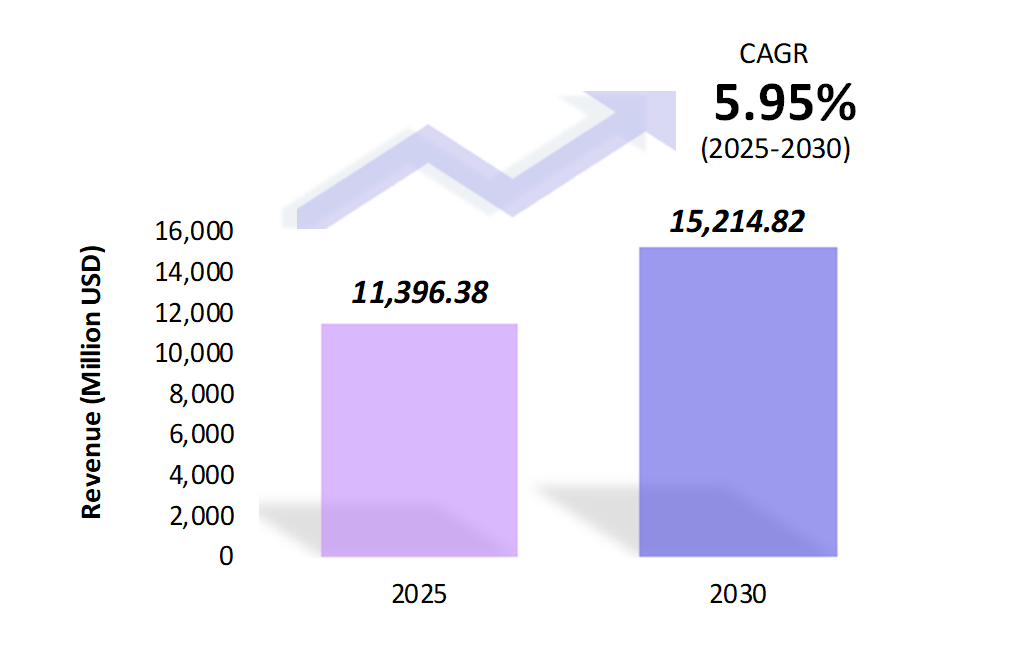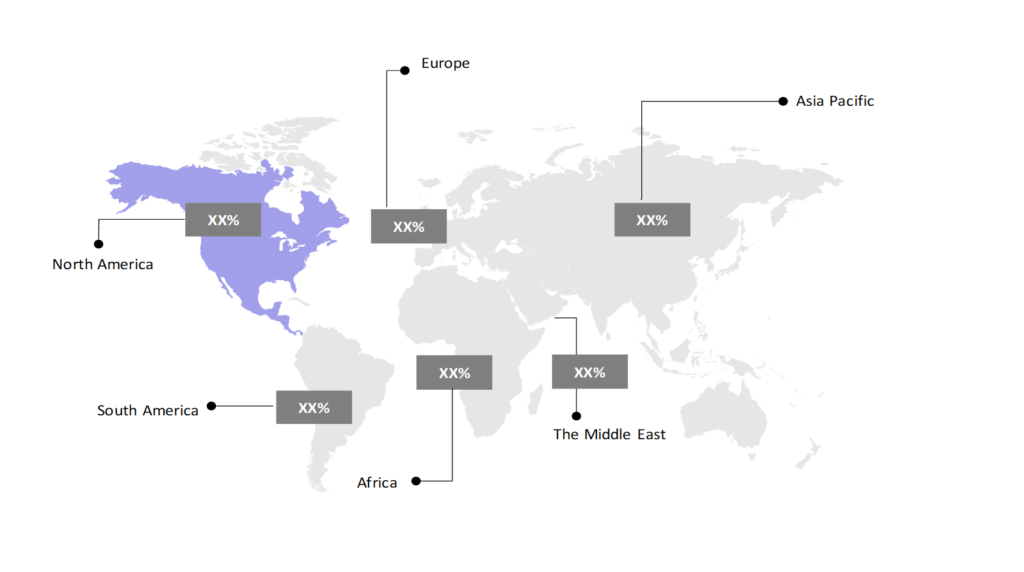Soy Protein Market Analysis: Growth, Size, Share & Future Trends (2024-2029)
The market report offers a detailed analysis segmented by Form (Concentrates, Isolates, Textured/Hydrolyzed); by End User (Animal Feed, Food and Beverages, Supplements); by Geography (North America, South America, Asia Pacific, Europe, The Middle East, Africa).
Outlook

- The soy protein market is estimated to be at USD 11,396.38 Mn in 2025 and is anticipated to reach USD 15,214.82 Mn in 2030.
- The soy protein market is registering a CAGR of 5.95% during the forecast period 2025-2030.
- The global soy protein market is expanding due to rising demand for plant-based protein sources, growing health consciousness, and advancements in the food processing industry.
Request a free sample.
Ecosystem

- The participants in the global soy protein industry are always developing their strategies to preserve a competitive advantage.
- These companies primarily use acquisitions, investments, research & developments, partnerships, and technological launches.
- Several important entities in the soy protein market include Archer Daniels Midland Co.; Wilmar International Ltd.; Fuji Oil Holdings Inc.; International Flavors & Fragrances Inc.; Kerry Group; and others.
Ask for customization.
Findings
| Attributes | Values |
|---|---|
| Historical Period | 2019-2023 |
| Base Year | 2024 |
| Forecast Period | 2025-2030 |
| Market Size (2025) | USD 11,396.38 Mn |
| Market Size (2030) | USD 15,214.82 Mn |
| Growth Rate | 5.95% CAGR from 2025 to 2030 |
| Key Segments | Form (Concentrates, Isolates, Textured/Hydrolyzed); End User (Animal Feed, Food and Beverages, Supplements); Geography (North America, South America, Asia Pacific, Europe, The Middle East, Africa) |
| Key Vendors | Archer Daniels Midland Co.; Wilmar International Ltd.; Fuji Oil Holdings Inc.; International Flavors & Fragrances Inc.; Kerry Group |
| Key Countries | The US; Canada; Mexico; Brazil; Argentina; Paraguay; China; India; Japan; The UK; Germany; France; Iran; Saudi Arabia; Nigeria; South Africa |
| Largest Market | North America |
Get a free quote.
Trends
- Innovations in Soy Protein Products: Food manufacturers are developing innovative soy protein products to meet evolving consumer preferences for texture, taste, and nutrition. For instance, in 2022, ADM launched a new line of high-protein soy snacks that offered unique flavors and increased bioavailability, enhancing the appeal of soy-based snacks in the market.
- Emergence of Functional and Fortified Foods: Soy protein’s nutritional profile and health benefits make it ideal for functional foods, particularly those focused on heart health, weight management, and immune support. In 2023, DuPont launched soy protein-fortified dairy alternatives, emphasizing their health advantages, including cholesterol reduction and muscle recovery.
- Development of Plant-Based Diets: As consumers embrace plant-based diets, soy protein is becoming a key alternative to meat and dairy products. Its versatility and nutritional profile make it a popular choice for those seeking healthier, sustainable options. This shift reflects a broader trend toward reducing animal product consumption in favor of plant-derived sources.
Speak to analyst.
Catalysts
- Increased Adoption in the Food Processing Industry: The versatility of plant-based proteins significantly drives their adoption across various food sectors. These proteins are increasingly utilized in developing meat analogs, dairy alternatives, and snacks, appealing to health-conscious consumers. Major companies are responding to the growing demand by innovating products that incorporate these alternatives, reflecting a commitment to sustainability and meeting evolving dietary preferences.
- Expansion in Sports Nutrition Market: The rising acceptance of soy protein in the fitness industry is a key market driver in sports nutrition. With its high amino acid content and digestibility, soy protein is increasingly seen as a viable alternative to animal-based proteins. In 2023, GNC’s launch of soy-based protein supplements for vegan athletes exemplifies the growing demand for plant-based options that support athletic performance, aligning with the trend toward sustainable protein sources.
- Supportive Government Policies and Investments: Government initiatives promoting plant-based proteins and funding for soy protein research and development are bolstering market growth. In 2023, the European Union increased funding for plant-based protein innovation, aiming to support local production and meet sustainability goals.
Inquire before buying.
Restraints
- Concerns Over Allergies and GMOs: Soy protein faces significant market challenges due to consumer concerns about allergies and genetically modified organisms (GMOs). Many potential users are hesitant to incorporate soy protein into their diets because of fears of allergic reactions. Furthermore, the controversy surrounding GMOs leads some consumers to prefer non-GMO alternatives, limiting the overall acceptance of soy protein. These issues hinder market growth despite the rising interest in plant-based options.
- Price Fluctuations in Soybeans: Price volatility in soybeans poses a significant challenge for the soy protein market, influenced by factors such as climate change, trade policies, and supply chain disruptions. For instance, the 2022 drought in Brazil, a key soybean producer, resulted in substantial price hikes. This instability forces manufacturers to navigate rising production costs while developing pricing strategies that remain competitive, ultimately impacting profitability and market accessibility.
- Environmental and Ethical Issues of Soy Farming: Soy cultivation is increasingly associated with deforestation and biodiversity loss, presenting a market challenge as consumers increasingly seek eco-friendly practices. The negative environmental impact of soybean farming could deter environmentally conscious buyers from choosing soy protein products. As awareness of sustainability grows, companies may face pressure to adopt more responsible sourcing and farming practices to maintain consumer trust and market share.
Personalize this research.
Hotspot

Explore purchase options.
Table of Contents
| 1. Introduction 1.1. Research Methodology 1.2. Scope of the Study 2. Market Overview / Executive Summary 2.1. Global Soy Protein Market (2019 – 2023) 2.2. Global Soy Protein Market (2024 – 2030) 3. Market Segmentation 3.1. Global Soy Protein Market by Form 3.1.1. Concentrates 3.1.2. Isolates 3.1.3. Textured/Hydrolyzed 3.2. Global Soy Protein Market by End User 3.2.1. Animal Feed 3.2.2. Food and Beverages 3.2.3. Supplements 4. Regional Segmentation 4.1. North America 4.1.1. The US 4.1.2. Canada 4.1.3. Mexico 4.2. South America 4.2.1. Brazil 4.2.2. Argentina 4.2.3. Paraguay 4.2.4. Rest of South America 4.3. Asia Pacific 4.3.1. China 4.3.2. India 4.3.3. Japan 4.3.4. Rest of Asia Pacific 4.4. Europe 4.4.1. The UK 4.4.2. Germany 4.4.3. France 4.4.4. Rest of Europe 4.5. The Middle East 4.5.1. Iran 4.5.2. Saudi Arabia 4.5.3. Rest of the Middle East 4.6. Africa 4.6.1. Nigeria 4.6.2. South Africa 4.6.3. Rest of Africa 5. Value Chain Analysis of the Global Soy Protein Market 6. Porter Five Forces Analysis 6.1. Threats of New Entrants 6.2. Threats of Substitutes 6.3. Bargaining Power of Buyers 6.4. Bargaining Power of Suppliers 6.5. Competition in the Industry 7. Trends, Drivers and Challenges Analysis 7.1. Market Trends 7.1.1. Market Trend 1 7.1.2. Market Trend 2 7.1.3. Market Trend 3 7.2. Market Drivers 7.2.1. Market Driver 1 7.2.2. Market Driver 2 7.2.3. Market Driver 3 7.3. Market Challenges 7.3.1. Market Challenge 1 7.3.2. Market Challenge 2 7.3.3. Market Challenge 3 8. Opportunities Analysis 8.1. Market Opportunity 1 8.2. Market Opportunity 2 8.3. Market Opportunity 3 9. Competitive Landscape 9.1. Archer Daniels Midland Co. 9.2. Wilmar International Ltd. 9.3. Fuji Oil Holdings Inc. 9.4. International Flavors & Fragrances Inc. 9.5. Kerry Group 9.6. Company 6 9.7. Company 7 9.8. Company 8 9.9. Company 9 9.10. Company 10 |
Know the research methodology.
Soy Protein Market – FAQs
1. What is the current size of the soy protein market?
Ans. In 2025, the soy protein market size is USD 11,396.38 Mn.
2. Who are the major vendors in the soy protein market?
Ans. The major vendors in the soy protein market are Archer Daniels Midland Co.; Wilmar International Ltd.; Fuji Oil Holdings Inc.; International Flavors & Fragrances Inc.; Kerry Group.
3. Which segments are covered under the soy protein market segments analysis?
Ans. The soy protein market report offers in-depth insights into Form, End User, and Geography.
